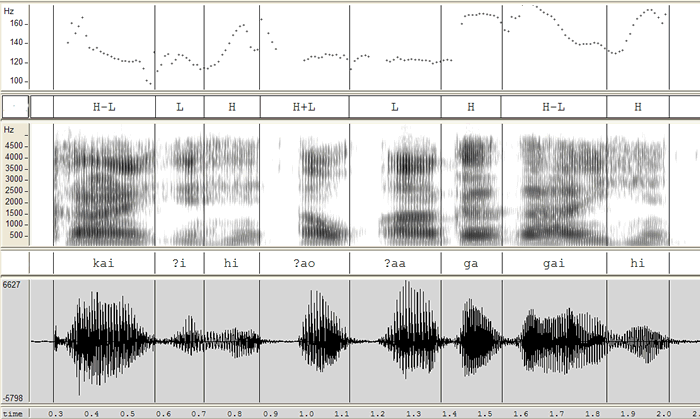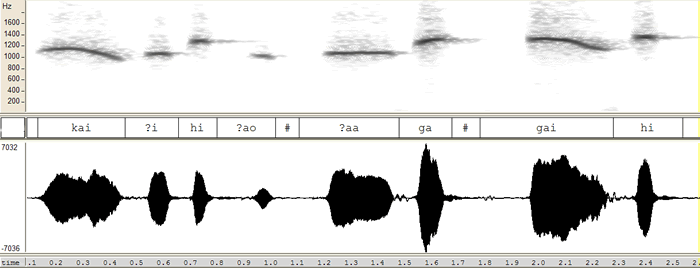May 21, 2006
Pirahã channels
According to Daniel L. Everett, "Cultural Constraints on Grammar and Cognition in Pirahã: Another Look at the Design Features of Human Language", Current Anthropology, Volume 46, Number 4, August-October 2005 (preprint for those without a subscription):
The Pirahã people communicate almost as much by singing, whistling, and humming as they do using consonants and vowels.
Dan explains the contextual functions of these "channels" as follows:
Channel |
Functions |
| a. Hum speech | Disguise Privacy Intimacy Talk when mouth is full Child language acquisition relation |
| b. Yell speech | Long distance Rainy days Most frequent use – between huts & across river |
| c. Musical speech ('big jaw') | New information Spiritual communication Dancing, flirtation Women produce this in informant sessions more naturally than men. Women's musical speech shows much greater separation of high and low tones, greater volume. |
| d. Whistle speech (sour or 'pucker mouth' -- same root as 'to kiss' or shape of mouth after eating lemon) |
Hunting Men-only (as in ALL whistle speeches!) One unusual melody used for aggressive play |
Lots of other cultures have ways of expressing speech as whistling, drumming, or chanting. What seems to be unusual about the Pirahã is the relatively large role of these other "channels" (as Dan calls them) in everyday life. As Dan suggests, this may be connected to the fact that Pirahã has a small number of consonant-vowel distinctions
The consonants of Pirahã are /p b t k g ' h/ and, in men's speech only, /s/, and the vowels are /i a o/
and a relatively complex system of syllable-weight, stress and tone. Whistling and humming preserve the prosodic distinctions and blur or eliminate the distinctions among different consonants and vowels. Thus it'll be easier to understand what someone is humming (for example) in a language where there's more information in timing, stress and tone, and less information in consonant and vowel distinctions.
But in my opinion, the most interesting aspect of this situation is what Dan calls "the sloppy phoneme effect", which allows for a "tremendous amount of variation among consonants" in ordinary speech. For example, there's apparently free substitution of /'/ (glottal stop), /p/ and /k/, as in the word for "head", which can be any of:
'apapaí kapapaí papapaí 'a'a'aí kakakaí
(and so on) but not
*tapapaí *tatataí *bababaí *gagagaí *gagagaí *aaaí
or other examples where voiced consonants or no consonants are substituted. Some (though not all) of this variation is equivalent to preserving the syllable-weight classes involved in the Pirahã stress rule, and thus sets up equivalence-classes of words in ordinary speech similar to the equivalence-classes of hummed or whistled "channels".
[A side note for the linguists among you -- I don't know why Dan describes things this way, rather than saying that glottal stop, /k/ and /p/ are actually just allophones of a single underlying phoneme. Perhaps the statistical variation is lexically modulated in a way that makes clear that one word is basically /kaka/ while another is basically /papa/, even though both can in principle be any of [kaka] [kapa] [paka] [papa] (adding in the glottal-stop variants as appropriate)? That would be fascinating but very unexpected.]
To make all this less abstract, here are a couple of examples. First, an .mp3 recording of two boys conversing in musical speech ("big jaw"), from the "enhancements" of the cited Current Anthropology paper. I believe that this is roughly a "hey guess what I did today" conversation, but unfortunately I don't have a transcript, a rendition in normal speaking mode, or any further explanation. Nor do I have any examples of "hum speech" to show you.
Here's the example of whistled speech that Dan gives in the cited article, with spoken and whistled version performed by Dan himself (he kindly sent it from a hotel room in Brazil, where he was on his way to another summer of field work). First the basic sentence, kái'ihí'ao 'aagá gáhí "there is a paca" (audio link):
| (syllables) | kái |
'i |
hí |
'ao |
'aa |
gá |
gái |
hí |
| (tones) | H-L |
L |
H |
H+L |
L |
H |
H-L |
H |
| (syllable weight) | ||||||||
| (stress) | ↑ |
↑ |
↑ |
|||||
| (glosses) | paca | possible | exist-be | there | ||||
| (translation) | "there is a paca" |
|||||||
(I guess that this is the "hunting" kind of whistle speech, rather than the "agressive play" kind.)
Here's a picture showing the pitch contour, spectrogram and waveform of the spoken version (note that I've used "?" to mark glottal stop in this case -- sorry for the lack of consistency):
Here's an audio link to Dan's whistled version. The picture below shows a "narrow-band" spectrogram, to make the pitch of the whistling plain, along with the waveform.
(The whistled version is somewhat longer, in this case -- 2.34 seconds versus 1.759 seconds, or about a third longer. This might just be because Dan is a less-practiced whistler than speaker.)
For any and all of the alternative-channel versions of speech across the world's languages, it would be nice to have a collection of analyzed examples that was large enough for some quantitative analysis. Depending on the complexity of the system and the amount of variability in it, that would be several thousand phrases at a minimum, and of course the more the better. This may exist, at least in museum or library archives, for some of the cases (e.g. Vedic chanting and Yoruba drumming), but I don't know of any published (or even accessibly unpublished) examples.
Posted by Mark Liberman at May 21, 2006 08:52 AM
